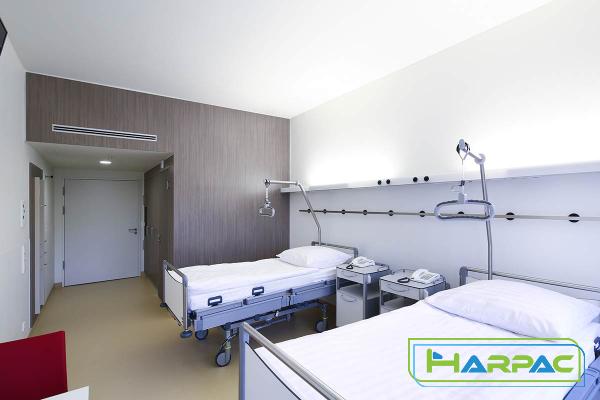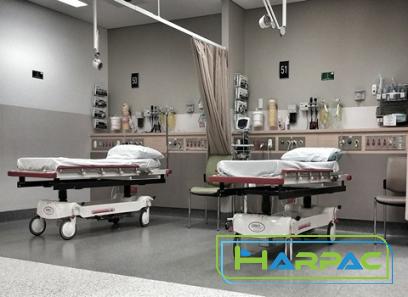Hospital beds play a crucial role in patient care, providing comfort, support, and safety. While traditional hospital beds often come equipped with side rails, there is a growing demand for alternatives that offer more versatility and convenience. In this article, we will explore the benefits and features of hospital beds without rails. Improved Accessibility: One of the key advantages of hospital beds without rails is enhanced accessibility. These beds allow patients to easily get in and out of bed independently, promoting their sense of autonomy and freedom. Whether it’s walking to the bathroom or moving around in the room, patients can navigate with greater ease, reducing the need for assistance. Enhanced Patient Experience: Hospital stays can be challenging, and patients deserve the utmost comfort during their recovery.

.
 Beds without rails offer a more homely environment, enabling patients to feel less confined and restricted. This can contribute to a more positive mindset, leading to faster healing and overall better patient outcomes. Flexibility for Medical Procedures: Hospital beds without rails provide greater flexibility when performing medical procedures, such as surgeries or imaging tests. Without rails obstructing access to the patient, medical professionals can maneuver equipment and position patients more easily. This increased flexibility ensures that medical interventions can be conducted smoothly and efficiently, saving valuable time and resources.
Beds without rails offer a more homely environment, enabling patients to feel less confined and restricted. This can contribute to a more positive mindset, leading to faster healing and overall better patient outcomes. Flexibility for Medical Procedures: Hospital beds without rails provide greater flexibility when performing medical procedures, such as surgeries or imaging tests. Without rails obstructing access to the patient, medical professionals can maneuver equipment and position patients more easily. This increased flexibility ensures that medical interventions can be conducted smoothly and efficiently, saving valuable time and resources.
..
 Fall Prevention Measures: While traditional hospital beds with side rails are often used to prevent patient falls, the use of rails is not always the most suitable solution. Many patients find rails claustrophobic or confining, leading to restlessness and discomfort. Hospital beds without rails can still incorporate fall prevention measures, such as adjustable bed height and bed alarms, ensuring patient safety without compromising their comfort. Ease of Cleaning and Maintenance: Hospital beds without rails are designed to be easily cleaned and maintained. Without railings, there are fewer crevices or areas where dirt and bacteria can accumulate. This assists healthcare staff in maintaining a high standard of cleanliness, reducing the risk of infections and promoting a healthier environment for patients. Customization Options: Hospital beds without rails also offer numerous customization options to suit individual patient needs.
Fall Prevention Measures: While traditional hospital beds with side rails are often used to prevent patient falls, the use of rails is not always the most suitable solution. Many patients find rails claustrophobic or confining, leading to restlessness and discomfort. Hospital beds without rails can still incorporate fall prevention measures, such as adjustable bed height and bed alarms, ensuring patient safety without compromising their comfort. Ease of Cleaning and Maintenance: Hospital beds without rails are designed to be easily cleaned and maintained. Without railings, there are fewer crevices or areas where dirt and bacteria can accumulate. This assists healthcare staff in maintaining a high standard of cleanliness, reducing the risk of infections and promoting a healthier environment for patients. Customization Options: Hospital beds without rails also offer numerous customization options to suit individual patient needs.
…
 These options may include adjustable sections for head and leg elevation, pressure-relieving mattresses, and various positioning capabilities. By tailoring the bed to their requirements, patients receive optimal support and comfort during their recovery. Conclusion: Hospital beds without rails have emerged as a versatile and convenient alternative to traditional beds, providing patients with improved accessibility, enhanced comfort, and ease of medical procedures. Healthcare facilities that prioritize patient-centered care can benefit from incorporating these beds into their equipment inventory, ensuring the well-being and satisfaction of their patients. With their flexible design, ease of maintenance, and numerous customization options, hospital beds without rails prove to be a valuable asset in modern healthcare settings.
These options may include adjustable sections for head and leg elevation, pressure-relieving mattresses, and various positioning capabilities. By tailoring the bed to their requirements, patients receive optimal support and comfort during their recovery. Conclusion: Hospital beds without rails have emerged as a versatile and convenient alternative to traditional beds, providing patients with improved accessibility, enhanced comfort, and ease of medical procedures. Healthcare facilities that prioritize patient-centered care can benefit from incorporating these beds into their equipment inventory, ensuring the well-being and satisfaction of their patients. With their flexible design, ease of maintenance, and numerous customization options, hospital beds without rails prove to be a valuable asset in modern healthcare settings.










Your comment submitted.